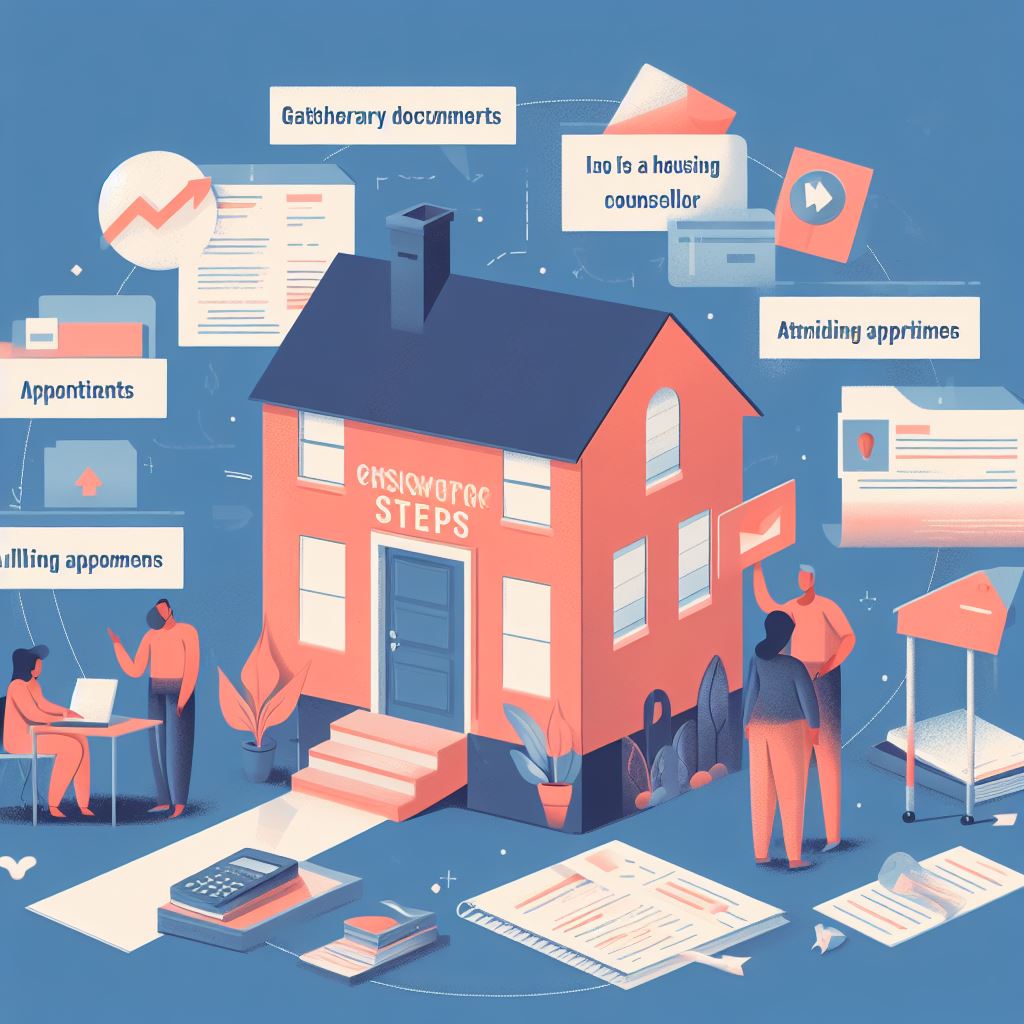12 Essential Steps to Navigate Section 8 Housing Application

Looking to apply for Section 8 housing? You’re not alone. In fact, over 2 million low-income households benefit from this program every year.
But navigating the application process can be overwhelming. That’s why we’ve put together this guide outlining the 12 essential steps to help you successfully navigate the Section 8 housing application.
From determining eligibility to maintaining compliance, we’ve got you covered.
So let’s get started on your journey to secure affordable housing.
Key Takeaways
- Meeting income requirements is crucial for Section 8 eligibility.
- Accurate and up-to-date documentation is necessary for the application.
- Research and gather information about Section 8 Housing Authorities.
- Carefully review the application, submit it accurately and on time.
Determine Eligibility
To determine if you’re eligible for Section 8 housing, you must meet certain income requirements and provide the necessary documentation.
The primary factor that determines eligibility for Section 8 housing is your household income. The program is designed to assist low-income individuals and families, so there’s a maximum income limit that you mustn’t exceed. This limit varies depending on the area you live in and the size of your household. You can find the specific income limits for your area on the U.S. Department of Housing and Urban Development (HUD) website.
In addition to meeting the income requirements, you’ll also need to gather the necessary documentation to support your application. This includes proof of income, such as pay stubs or tax returns, as well as identification documents for all household members. It’s important to ensure that all the information provided is accurate and up to date, as any discrepancies may delay or even disqualify your application.
Once you have gathered all the necessary documentation, you can then proceed with the application process for Section 8 housing.
Collect Required Documents
Gather the necessary documents for your Section 8 housing application.
Ensuring you have all the required paperwork ready will help streamline the application process and avoid any delays. Here are the key documents you need to collect:
- Proof of identity: Provide a valid government-issued photo ID, such as a driver’s license or passport, to verify your identity.
- Proof of income: Gather documents that demonstrate your household’s income, including pay stubs, tax returns, and bank statements. This will help determine your eligibility and calculate your rental assistance.
- Social Security numbers: Make sure to have the Social Security numbers of all household members readily available. This information is necessary for the application.
- Rental history: Obtain a letter from your current landlord or property manager confirming your rental history. This letter should include the dates you have lived at your current residence and verify your timely payment of rent.
Understand Income Limits
To successfully navigate the Section 8 housing application process, it’s essential to understand the income limits set by the program. These limits determine if you’re eligible for assistance and how much assistance you may receive.
You’ll need to provide documentation to verify your income, such as pay stubs, tax returns, and bank statements, to ensure you meet the income requirements.
Eligibility Requirements for Income
Understand your income limits to determine your eligibility for Section 8 housing. Here are four key factors to consider when assessing your income for Section 8:
- Gross income: This includes all the income you receive before any deductions. It includes wages, salaries, self-employment income, and any other income sources.
- Household size: The size of your household, including yourself, your spouse, children, and any other individuals you claim as dependents, affects the income limits for Section 8. The larger your household, the higher your income limit can be.
- Income sources: Section 8 takes into account all sources of income, including wages, pensions, Social Security benefits, disability payments, and child support. Make sure to accurately report all sources of income.
- Income limits: Each area has different income limits for Section 8. These limits are based on the area’s median income and are adjusted for household size. Check with your local Public Housing Authority to find out the income limits for your area.
Understanding these income requirements is crucial for determining your eligibility for Section 8 housing assistance. Make sure to gather all the necessary information and accurately report your income to increase your chances of qualifying for this program.
Documentation Needed for Verification
Make sure you have the necessary documents to verify your income limits for Section 8 housing. When applying for Section 8, you’ll be required to provide proof of your income to determine your eligibility.
The documentation needed may vary depending on your specific situation, but commonly required documents include pay stubs, tax returns, bank statements, and proof of any other sources of income such as social security benefits or child support.
It’s important to gather all relevant documents and ensure they’re up to date and accurate. Additionally, be prepared to provide documentation for all household members, including their social security numbers and birth certificates.
Locate Section 8 Housing Authorities
When looking to locate Section 8 Housing Authorities, you can start by researching online or contacting your local housing agency. Here are four essential steps to help you find the Section 8 Housing Authorities in your area:
- Research online: Visit the official website of the U.S. Department of Housing and Urban Development (HUD) to access a comprehensive list of Section 8 Housing Authorities nationwide. This resource will provide you with contact information and links to local housing agencies in your state.
- Contact your local housing agency: Reach out to your local housing agency directly to inquire about Section 8 Housing Authorities in your area. They’ll be able to provide you with up-to-date information about the application process, available housing options, and any specific requirements or preferences.
- Connect with community organizations: Local community organizations, such as non-profit housing advocacy groups or social service agencies, often have valuable resources and information about Section 8 Housing Authorities. Get in touch with these organizations to tap into their knowledge and assistance.
- Attend tenant workshops or seminars: Many housing agencies organize workshops or seminars for tenants interested in Section 8 housing. These events can provide you with a wealth of information about the application process, tenant rights and responsibilities, and other important details.
Complete the Application Form
To successfully complete the Section 8 housing application, you’ll need to gather the required documentation. This may include proof of income, identification, and household composition. Make sure to carefully review the application instructions and double-check that you have included all necessary documents to avoid any delays or rejection.
Additionally, be aware of common mistakes that can hinder your application process. These include providing inaccurate information or not filling out all sections of the form. By taking the time to gather the necessary documentation and carefully review your application, you can increase your chances of a successful application process.
Required Documentation for Application
Completing the application form for Section 8 housing requires you to carefully gather and submit all the required documentation. Here are four essential documents you’ll need to include:
- Proof of identity: You’ll need to provide a valid government-issued ID, such as a driver’s license or passport, to verify your identity.
- Proof of income: This includes pay stubs, bank statements, or tax returns to demonstrate your income level and eligibility for Section 8 assistance.
- Proof of residency: You must show that you currently live in the area where you’re applying for Section 8 housing. This can be done through utility bills, lease agreements, or other documents that verify your address.
- Social Security numbers: You’ll need to provide the Social Security numbers for all household members listed on the application form.
Common Application Mistakes
By carefully completing the application form for Section 8 housing, you can avoid common mistakes and increase your chances of a successful application.
The application form is a crucial part of the process, and it’s important to fill it out accurately and completely. One common mistake is failing to provide all the required information. Make sure to answer every question and provide all the necessary documents.
Another mistake isn’t double-checking your application for errors or missing information. Take the time to review your application before submitting it to ensure everything is correct.
Additionally, be aware of the deadline for submitting your application and make sure to submit it on time.
Avoid these common mistakes to improve your chances of securing Section 8 housing.
Submit the Application
Once you have gathered all the necessary documents and completed the application form, it’s time to submit your Section 8 Housing application. Here are the essential steps to successfully submit your application:
- Review your application: Before submitting, carefully review your application for any errors or missing information. Double-check that all the required fields are filled out accurately.
- Make copies: It’s always a good idea to make copies of your completed application and supporting documents. This will serve as a backup in case anything gets lost or misplaced.
- Submitting options: Determine the submission method for your Section 8 Housing application. You can usually submit it online, in person, or by mail. Check with your local housing authority to see which option is available.
- Follow instructions: Pay close attention to the submission instructions provided by your local housing authority. They may require additional documents or have specific instructions on where and how to submit your application.
Attend the Housing Interview
Now that you have submitted your application, it’s time to prepare for the housing interview.
To ensure a smooth process, make sure you gather all the required documents beforehand. This includes your identification, proof of income, and rental history.
Be prepared to answer common interview questions about your household size, income, and any special circumstances that may affect your housing needs.
Interview Preparation Tips
To prepare for the housing interview, you should gather all necessary documents and familiarize yourself with the Section 8 program requirements. Here are four tips to help you prepare:
- Review the Section 8 program requirements: Make sure you understand the eligibility criteria, income limits, and other key factors that determine your eligibility for the program.
- Collect all required documents: Gather important documents such as proof of income, identification, and any other documents specified by the housing authority. Having these documents ready will help streamline the application process.
- Be prepared to discuss your housing needs: Think about your current living situation and what specific needs you have in terms of housing. Be prepared to discuss these needs during the interview.
- Dress appropriately and arrive on time: Treat the housing interview as a formal appointment. Dress professionally and arrive on time to make a good impression.
Required Documents Checklist
Before attending the housing interview, you’ll need to gather and bring several required documents. These documents are essential for the application process and will help determine your eligibility for Section 8 housing. To ensure a smooth interview process, make sure to have the following documents ready:
- Identification: Bring a valid government-issued ID for all members of your household.
- Social Security Cards: Provide a copy of the Social Security cards for each household member.
- Proof of Income: Bring recent pay stubs, tax returns, or other documents that verify your income.
- Proof of Assets: Provide documentation of any assets such as bank statements, investments, or property ownership.
- Rental History: Bring a list of previous addresses and landlord contact information.
- Birth Certificates: Provide birth certificates for all household members.
- Citizenship or Immigration Status: Bring documentation that verifies your citizenship or immigration status.
Common Interview Questions
During the housing interview, you can expect to be asked common questions about your eligibility for Section 8 housing. To help you prepare, here are four common interview questions you may encounter:
- What’s your current income? The interviewer will want to verify that your income falls within the income limits set by the Section 8 program.
- Do you have any dependents? This question helps determine the size of the household and the appropriate amount of assistance needed.
- Have you ever been evicted? The interviewer will inquire about your rental history to assess your reliability as a tenant.
- Do you have any criminal convictions? The Section 8 program has certain restrictions regarding criminal backgrounds, and the interviewer will need to evaluate your eligibility based on this information.
Being prepared for these questions will help you navigate the housing interview process smoothly and increase your chances of being approved for Section 8 housing.
Review the Waiting List
Check the waiting list to see where you stand in the Section 8 housing application process. The waiting list is an essential part of the Section 8 program, as it determines the order in which applicants will receive assistance. By reviewing the waiting list, you can gain insight into your current position and estimate how long you may need to wait before receiving housing assistance.
To help you understand the waiting list process better, here is a table outlining the different statuses and their meanings:
| Status | Meaning |
|---|---|
| Active | Your application is active, and you are eligible for housing |
| Inactive | Your application is inactive due to missing information |
| Pending | Your application is under review by the housing authority |
| Approved | Your application has been approved, and you are on the waiting list |
It is important to regularly check the waiting list to stay informed about any updates or changes to your application status. Keep in mind that the waiting time can vary significantly based on factors such as demand, availability of housing units, and your preference for location. If you have any questions or concerns about your position on the waiting list, contact your local housing authority for assistance.
Receive Voucher Notification
Once your application is approved, you’ll receive a notification regarding your Section 8 housing voucher. This notification is an important step in the process, as it signifies that you’re now eligible to receive rental assistance through the Section 8 program.
Here are four essential things to know about receiving your voucher notification:
- Timing: The timing of when you receive your voucher notification can vary. It may take several weeks or even months for your application to be reviewed and approved. Patience is key during this waiting period.
- Method of notification: You’ll typically receive your voucher notification by mail. It’s important to keep your contact information up to date to ensure you receive the notification promptly.
- Contents of the notification: The voucher notification will contain important information, such as the date your voucher becomes effective, the amount of rental assistance you’ll receive, and the time frame in which you must find suitable housing.
- Follow-up steps: Once you receive your voucher notification, you’ll need to take action. This may include attending a briefing session, finding a landlord willing to accept Section 8 vouchers, and submitting necessary paperwork to the housing authority.
Receiving your Section 8 voucher notification is an exciting step towards securing affordable housing. Be sure to read and understand the contents of the notification and follow the necessary steps to move forward in the process.
Find a Section 8 Rental
To secure affordable housing through the Section 8 program, you’ll need to actively search for a landlord who accepts Section 8 vouchers. Here are some essential steps to help you find a Section 8 rental.
- Contact your local Public Housing Authority (PHA): Reach out to your PHA to get a list of landlords who participate in the Section 8 program. They can provide you with information on available rentals and help you understand the process.
- Utilize online resources: Websites like GoSection8.com and social media groups dedicated to Section 8 rentals can help you find landlords who accept Section 8 vouchers. These platforms allow you to search for rentals based on location and specific requirements.
- Network with other Section 8 participants: Connect with other Section 8 participants in your community. They may have valuable insights and recommendations on landlords who are open to renting to voucher holders.
- Work with a housing counselor: Consider seeking assistance from a housing counselor who specializes in Section 8 housing. They can guide you through the process, provide resources, and help you navigate any challenges.
Sign the Lease Agreement
Before signing the lease agreement, make sure you thoroughly review all terms and conditions. This step is crucial to ensure that you understand your rights and responsibilities as a tenant. Here are four important things to consider before signing the lease agreement:
- Rent Amount and Payment Terms: Carefully review the rent amount stated in the lease agreement and ensure it matches what you agreed upon with the landlord. Also, check the payment terms, such as the due date, late fees, and acceptable payment methods.
- Lease Duration: Confirm the lease duration specified in the agreement. It’s essential to know how long you’re committing to the rental property. If you have any concerns about the lease term, discuss them with the landlord before signing.
- Maintenance and Repairs: Understand the landlord’s responsibilities for maintaining the property and making repairs. The lease agreement should outline who’s responsible for specific repairs and how they should be reported.
- Rules and Restrictions: Familiarize yourself with any rules and restrictions outlined in the lease agreement. These may include pet policies, noise regulations, or restrictions on making alterations to the property. Make sure you’re comfortable with these rules before signing.
Maintain Section 8 Compliance
To maintain Section 8 compliance, it’s important to understand and adhere to the program’s regulations and requirements. The Section 8 program is designed to assist low-income individuals and families in accessing affordable housing. As a participant, it’s crucial to follow certain guidelines to ensure ongoing eligibility and compliance.
Firstly, it’s essential to report any changes in your household income or composition to the housing authority promptly. Failure to do so may result in a violation of the program rules. Additionally, you must inform the housing authority if you’re planning to move or transfer to another unit. This will help ensure a smooth transition and prevent any disruptions in your housing assistance.
Furthermore, it’s necessary to maintain the rental unit in a safe and sanitary condition. Regular inspections will be conducted to ensure compliance with housing quality standards. It’s your responsibility to address any repair issues promptly and keep the property in good condition.
Lastly, it’s crucial to pay your portion of the rent on time and in full. Failure to do so may lead to termination from the program. It’s recommended to establish a budget and prioritize rent payments to avoid any financial difficulties.
Frequently Asked Questions
What Is the Maximum Income Limit to Qualify for Section 8 Housing?
The maximum income limit to qualify for Section 8 housing depends on various factors such as family size and location. It is important to check with your local housing authority for the specific income limits in your area.
Can I Apply for Section 8 Housing if I Am Currently Homeless?
Yes, you can apply for Section 8 housing if you are currently homeless. The program is designed to assist low-income individuals and families, including those experiencing homelessness, in finding affordable and suitable housing options.
How Long Does It Typically Take to Receive a Section 8 Voucher After Submitting the Application?
After submitting your Section 8 housing application, it typically takes some time to receive a voucher. The exact timeframe may vary, but it can take anywhere from a few weeks to several months.
Are There Any Restrictions on the Type or Location of Rental Properties That Can Be Used With a Section 8 Voucher?
There are restrictions on the type and location of rental properties for Section 8 vouchers. The property must meet certain criteria and be approved by the housing authority. It’s important to research and understand these guidelines before making any decisions.
Can I Transfer My Section 8 Voucher to Another City or State if I Need to Relocate?
Yes, you can transfer your Section 8 voucher to another city or state if you need to relocate. This allows you to continue receiving housing assistance in your new location.



